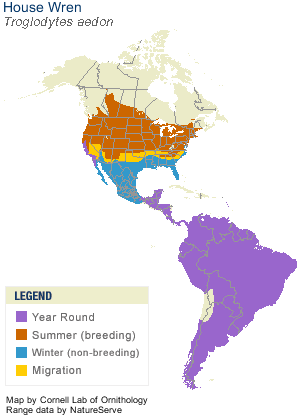Physical Description
Male and female House Wrens look alike. They have grayish brown upperparts, buff or pale-buff underparts, and faint buff or dusky brown eyebrows. Juveniles have a reddish brown rump, and their underparts are a darker buff.
Distribution and Breeding Habitat
House Wrens occupy the northern two-thirds of the United States and parts of Canada. They breed in forest edges, shrub lands, swamps, fields, farmlands, and suburban parks.

Diet
Gleaning their food from tree foliage, House Wrens feast on a variety of invertebrates, including millipedes, spiders, snails, caterpillars, grasshoppers, ants, and beetles.
Pair Formation and Territoriality
The male arrives first on the breeding territory. Once he establishes a territory, he builds "dummy nests" in all available cavities on his territory. When the female arrives, she selects a nest site that may or may not be one of the nests started by the male.
House Wrens are very territorial. Although they use only one nest cavity at a time, they vigorously defend all cavities in their territory. As part of this defense, House Wrens often pierce and destroy the eggs of other cavity-nesting species such as Eastern Bluebirds and Tree Swallows that attempt to nest within their territory.
Nesting Behavior
The House Wren's mating system is complex. A male may pair with one female for part of the season to raise a brood. He might then mate with a different female to raise the second or third brood of the breeding season. Males may also be mated to two females simultaneously.
Nest Building: The breeding season begins in late April for birds living in the southern portion of their range; it begins in early May in the northern portion. House Wrens nest in natural cavities, tree stumps, woodpecker holes, building nooks and crannies, and in nest boxes. They have also been known to nest in such unique places as cow skulls, flower pots, tin cans, boots, scarecrows, and the pockets of hanging laundry.
Males begin building the nest by filling the nest cavity with small sticks. Up to 500 sticks have been counted in a single nest. High behind this pile, the female constructs a nest cup from various soft materials, like feathers, hair, wool, spider cocoons, strips of bark, rootlets, moss, and trash.
Egg Laying: Females lay one egg per day until the clutch is complete. The average clutch size is 6 to 8 eggs, but up to 12 eggs have been reported. The eggs are glossy white, sometimes tinted with pink or buff. They are uniformly and profusely marked with fine pinkish brown, reddish brown, and brown specks, which sometimes form a ring near the larger end of the egg.
Incubation: The incubation period lasts 13 to 15 days. Females begin to incubate on the day the next-to-last, or penultimate, egg is laid. Males occasionally feed their mates during this period.
Nestling Care: Both adults care for the young. The young fledge after 12 to 18 days. Although able to fly, the fledglings continue to be fed by their parents for approximately two weeks. The female may begin to renest while young are still dependent; the male then becomes the primary caretaker of the young.
Pairs usually raise two broods per breeding season. Some pairs can successfully raise three broods.
Winter Movement and Dispersal
House Wrens migrate to the southern United States and Mexico for the winter. Males return to the same breeding territory year after year. There is no information on site fidelity in females.
There is no information on juvenile dispersal.